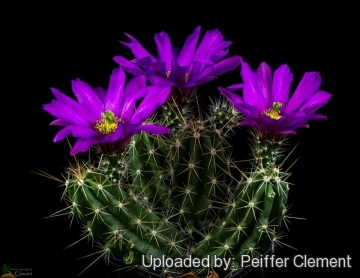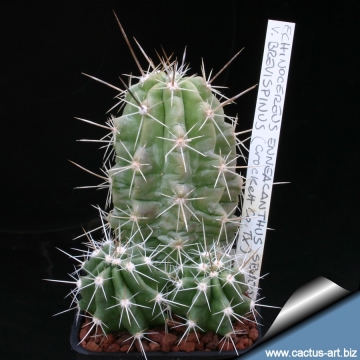Accepted Scientific Name: Echinocereus enneacanthus subs. brevispinus (W.O.Moore) N.P.Taylor
Cactaceae Consensus Init. 3: 8. 1997

Echinocereus enneacanthus f. brevispinus (Echinocereus enneacanthus subs. brevispinus) Photo by: Valentino Vallicelli
SB400 Crockett County, Texas, USA. The plants of this variety have very short spines.
Origin and Habitat: New Mexico, Texas and Northeastern Mexico (Sonora, Chihuahua, Durango, Nuevo León, San Luis Potosí and Coahuila)
Altitude range: 600-1800 metres above sea level.
Habitat: Chihuahuan desert scrub, flats, rarely rocky slopes, mostly on alluvial substrates, among riparian vegetation. Occasionally in limestone rocks, in various substrates including open habitats.
Synonyms:
See all synonyms of Echinocereus enneacanthus
Common Names include:
ENGLISH: Strawberry Hedghog Cactus, Prostrate Hedgehog, Cob Cactus, Hedghog Cactus, Green Strawberry, Alicoche Banana Cactus, Strawberry Cactus, Purple Pitaya, Prostrate Hedgehog Cactus, Pitaya, Smallspine Pitaya, Alicoche, Banana Cactus, Green Strawberry Hedgehog
SPANISH (Español): Órgano-pequeño, Alicoche Real, Pitaya
Description: Echinocereus enneacanthus subs. brevispinusSN|21835]]SN|21835]] is a caespitose cactus forming dense or lax flat-topped or rounded clumps either loose decumbent, or erect with 15-100(or more) branches, usually branching before flowering. It differs from var. enneacanthus for it thinner, and slender stems, areoles more closely set on the ribs and shorter spines. Except for differences in stem size, the habits of both var. enneacanthus and var. brevispinus are similar. Echinocereus enneacanthusSN|7930]]SN|7930]] and Echinocereus enneacanthus subs. brevispinusSN|21835]]SN|21835]] intergrade, at least in Maravillas Canyon and in the lower canyons of the Rio Grande. It seems best at present to regard enneacanthus and brevispinus as conspecific.
Derivation of specific name: The root word brevi is after the Latin brevis, which means short.
Stems: Up to 5 cm diameter up to over 100 cm long, The stems of this species are soft bright green and often remain wrinkled. The stem surface is readily visible through the relatively short spines.
Ribs: (6-)8-9(-10 prominent warty.
Areoles: circular, 10-15(-24) mm apart.
Radial spines: Needle-like brownish, bulbous at the base (6-)8-9(-13) per areole, 10-20 mm long. More straight compared to typically curving central spines of var. enneacanthus.
Central spines: Short and divergent 1-2 (to 3) per areole, 10-45(55) mm long.
Flowers: Purple-red to pink in varying shades, and diurnal. Blooming in spring (April-May). Similar in size or larger , to 8 cm long and 10 or more cm in diameter, compared to those of var. enneacanthus. Throat darker red. Filaments greenish or pinkish. Anthers yellow. Stile to 3 cm long, 1.5-2 mm thick with 6-12 green stigma lobes.
Fruit: Round pale green becoming or dull brownish-red, or ultimately turn red 25-38 mm long, 25 mm in diameter, pulp pale to intense pink. The fruit are edible. After the spines are removed from the green-brown flesh of the fruit, it can be eaten and tastes similar to, hence the name straswsberry cactus.
Seeds: Black, ovoid, 1-1.4 mm long, and prominently tuberculate.
Chromosome number: 2n = 22.
Bibliography: Major references and further lectures
1) Goettsch, B.K., Gómez-Hinostrosa, C., Heil, K., Terry, M. & Corral-Díaz, R. 2013. Echinocereus enneacanthus. In: IUCN 2013. "IUCN Red List of Threatened Species." Version 2013.2. <www.iucnredlist.org>. Downloaded on 16 January 2014.
2) Forrest Shreve, Ira Loren Wiggins “Vegetation and Flora of the Sonoran Desert” Volume 1 Stanford University Press, 1964
3) Edward Anderson “The Cactus family” Timber Press, Incorporated, 2001
4) James Cullen, Sabina G. Knees, H. Suzanne Cubey "The European Garden Flora Flowering Plants: A Manual for the Identification of Plants Cultivated in Europe, Both Out-of-Doors and Under Glass" Cambridge University Press, 11/Aug/2011
5) David R Hunt; Nigel P Taylor; Graham Charles; International Cactaceae Systematics Group. "The New Cactus Lexicon" dh books, 2006
6) Urs Eggli, Leonard E. Newton: “Etymological Dictionary of Succulent Plant Names” Springer, Berlin/Heidelberg 2010
7) Ulises Guzmán, Salvador Arias, Patricia Dávila "Catálogo de cactáceas mexicanas." Universidad Nacional Autónoma de México, Mexiko-State 2003
8) Delena Tull “Edible and Useful Plants of Texas and the Southwest: A Practical Guide” University of Texas Press, 1999
9) Brian Loflin, Shirley Loflin “Texas Cacti: A Field Guide” Texas A&M University Press, 26/Oct/2009
10) A. Michael Powell, James F. Weedin "Cacti of the Trans-Pecos & Adjacent Areas" Texas Tech University Press, 2004
 Echinocereus enneacanthus f. brevispinus (Echinocereus enneacanthus subs. brevispinus) Photo by: Peiffer Clement
Echinocereus enneacanthus f. brevispinus (Echinocereus enneacanthus subs. brevispinus) Photo by: Peiffer Clement Echinocereus enneacanthus f. brevispinus (Echinocereus enneacanthus subs. brevispinus) Photo by: Cactus Art
Echinocereus enneacanthus f. brevispinus (Echinocereus enneacanthus subs. brevispinus) Photo by: Cactus Art Echinocereus enneacanthus f. brevispinus (Echinocereus enneacanthus subs. brevispinus) Photo by: Cactus Art
Echinocereus enneacanthus f. brevispinus (Echinocereus enneacanthus subs. brevispinus) Photo by: Cactus ArtSend a photo of this plant.The gallery now contains thousands of pictures, however it is possible to do even more. We are, of course, seeking photos of species not yet shown in the gallery but not only that, we are also looking for better pictures than those already present.
Read More... Cultivation and Propagation: Rot easily it is sensitive to overwatering (rot prone) needs a very good drainage to avoid rotting, Keep drier and cool in winter. Need full sun. Very cold resistant It can withstand freezing temperatures but not too much water (resistant to approx -12C or less for short periods of time)
Propagation: Cuttings that are left out to callus off before planting. Also can be grown from seeds.













